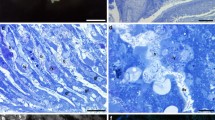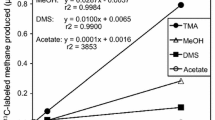Abstract
Seep Mytilid Ia (SMIa), an undescribed mussel found at hydrocarbon seeps in the Gulf of Mexico, harbors intracellular methanotrophic symbionts. Two techniques were used to address the hypothesis that host digestion of symbionts is a significant mechanism of carbon transfer from symbiont to host in the SMIa association: lysosomal enzyme cytochemistry and 14C tissue autoradiography. Acid phosphatase activity was consistently localized in the Golgi apparatus and associated vesicles of gill cells, but was detected around bacteria in only three of approximately 50 bacteriocytes examined. These results indicate that the cellular equipment necessary for lysosomal digestion of symbionts is present in host bacteriocytes, but that acid phosphatase activity in symbiont vacuoles is rare at a given point in time. Tissue autoradiography was conducted with mussels collected in September 1992 to document carbon fixation by symbionts and follow the time course of transfer to host tissues. No asymbiotic host cell type showed a significant increase in relative grain density until at least 1 d after the end of incubation with 14C-methane. The ratio of label in the basal portion of bacteriocytes to total bacteriocyte label did not show a significant increase until 10 d after the end of the incubation period, indicating a slow increase of labeled carbon in the putative residual bodies, containing the remnants of lysosomal digestion. These results are consistent with the hypothesis that host digestion of symbionts is one route of nutrient acquisition in SMIa. Intracellular methanotrophic bacteria were found outside of the gill in SMIa juveniles, in mantle and foot epithelial tissues previously believed to be symbiont-free. These extra-gill symbionts and their host cells are morphologically similar to their gill counterparts and, like the gill symbionts, actively fix carbon from methane.
Similar content being viewed by others
Author information
Authors and Affiliations
Additional information
Received: 29 March 1997 / Accepted: 12 May 1997
Rights and permissions
About this article
Cite this article
Streams, M., Fisher, C. & Fiala-Médioni, A. Methanotrophic symbiont location and fate of carbon incorporated from methane in a hydrocarbon seep mussel. Marine Biology 129, 465–476 (1997). https://doi.org/10.1007/s002270050187
Issue Date:
DOI: https://doi.org/10.1007/s002270050187




